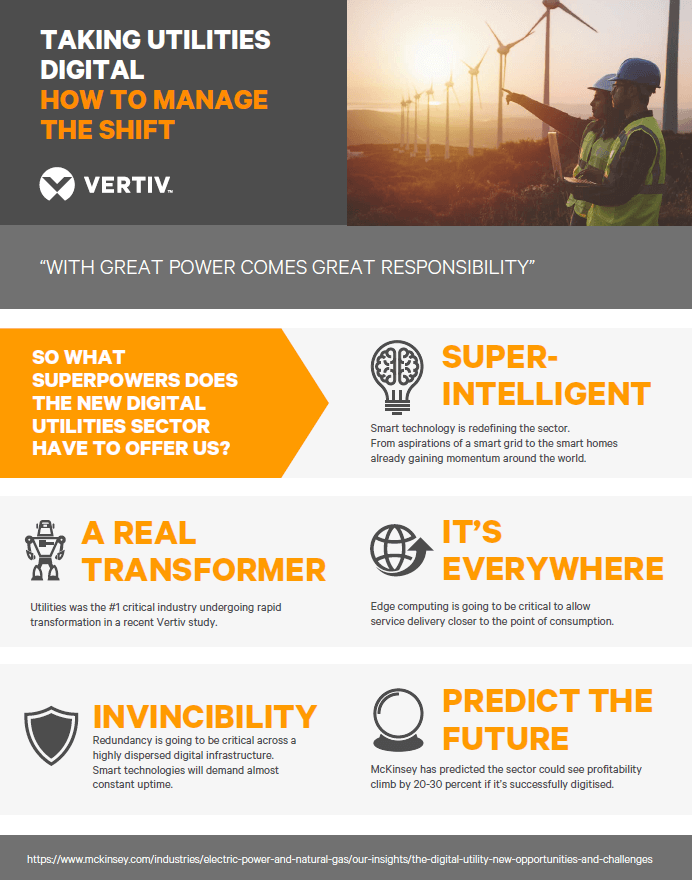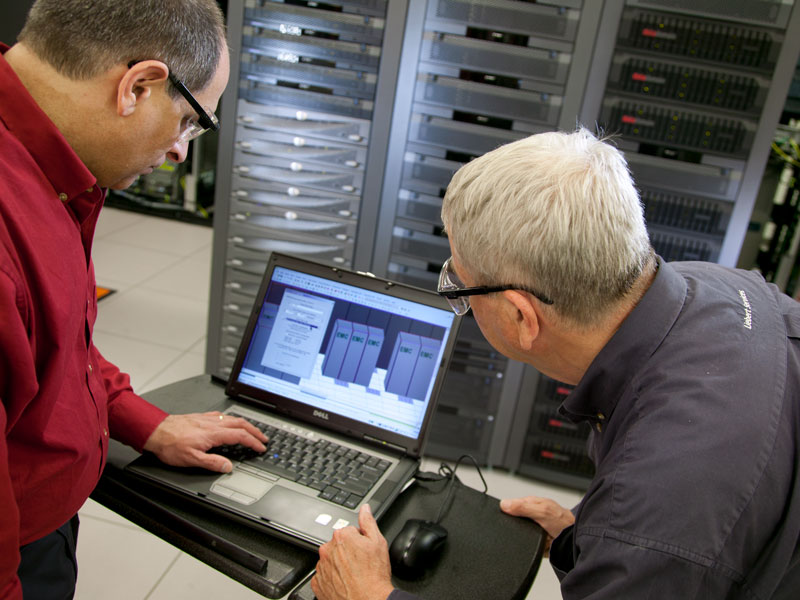Does digital dependency dictate doomsday scenario?
The digitisation of critical industries is transforming economies around the world. Yet, as we become more dependent on this digital infrastructure to enable economic progress, the consequences of any failure grow more catastrophic.
Against this backdrop it has become clear that one sector in particular underpins the success of every other industry - utilities. Whether the result of natural disaster, terrorism or simple human error, a significant period of downtime in the energy grid could grind the economy - and society as a whole - to a halt.
Meeting the needs of enterprises and individuals
The stark challenge for the utilities sector is precisely that we’re all reliant on it. It touches almost every facet of our daily lives. With a diverse customer base from the consumer to large enterprises, many organisations in electricity, gas and nuclear are in the midst of change. Indeed, a 2017 Vertiv report concluded that the high performance of the utilities industry is essential for the smooth running of our daily lives.
Yet, as you read on, those within the industry are handling a significant transformation in terms of how power is created and distributed. This isn’t just about a single sector responding to new pressures - it’s about modernisation of the framework that underpins the success of every other industry, of the entire economy. So these changes are about far more than just keeping the lights on.
A key driving force behind this is political pressure. Governments around the world are increasingly pushing the agenda of smart energy management to both commercial bodies and citizens. Only in July 2017, the UK government unveiled its plans to deliver a ‘smarter more flexible energy system’ that will give businesses and citizens greater control over their energy use. For such programmes to be delivered successfully, huge changes need to be made to the model of power distribution, changes that will rely on the performance of the industry’s digital infrastructure.
Smart change for smarter utilities
Moving from traditional models of service delivery to digital methods is made vastly more complex by the dispersed nature of utilities infrastructure. The sector as a whole is characterised by both digital and physical systems, distributed across national and international territory, and these need to work together to supply critical resources.
But it’s not just the physical management of change from analogue to digital resources that is going to prove difficult; the model by which the sector operates is fundamentally shifting.
Traditionally, the generation and distribution of energy has stemmed from a central point, being channeled far and wide to all corners of the country. Yet, the advent of smart energy and the smart grid is necessitating a shift to a more decentralised approach. Today, a range of smaller, more agile technologies are being used to distribute energy from locations closer to those homes and businesses they are serving. With connectivity at the core of this new model, utilities will become major proponents of the edge computing approach. As well as the provision of services, these distributed hubs will also become the source of vast quantities of data.
Undoubtedly this focus on smart energy is providing organisations with the opportunity to use the data now at their disposal to deliver personalised offers to their customers and a more reliable service across the country. According to McKinsey, the digital optimisation of the utilities industry could see profitability climb by 20-30 percent. The new approach does, however, raise key considerations for I&O professionals. Digitisation makes security, reliability and redundancy more important than ever, core capabilities that I&O teams must balance with the pace of change that is being driven by customer demand.
Infrastructure needs for smart utilities
The new distributed energy model and smart grid technology are going to be central to both maintaining the critical supply of power throughout the country today, and shaping the smart cities of tomorrow. Unsurprisingly I&O teams will be at the heart of this change.
Reliability and redundancy - The tool kit of the utilities firm is changing in a big way. This array of new devices and machines will depend on the provision of power to operate consistently, and the data they produce must be consistent and trusted. There will be intense pressure on technology professionals to predict the chances of any disruption to the service under both normal and more extreme conditions (as seen for example in eastern North America this winter).
While service disruption is hardly an accepted factor today, the changing demands of a digitised era will diminish any consumer or corporate patience when it comes to outages. With more data available, errors and poor risk management will become more visible, creating tighter SLAs against which I&O teams will need to deliver.
Securing resources - The greater our dependence on digital infrastructure, the more important it becomes to ensure security at every level. Utilities companies are going to have ever more complex networks, with edge computing hubs managing operational activity and service delivery. In addition to cybersecurity, avoiding digital breaches of the technology infrastructure, it will be essential to maintain physical security. Tech pros will need to depend on enclosures positioned in remote areas, as well as a spider’s web network pulling data from a vast geographical spread. The fusion of data protection, physical security and changes in digital infrastructure will prove a complex but critical success factor in the sector.
A lightbulb moment
Many of us may not think of the complexity that lies beneath the surface when we are adjusting our smart meters and enjoying the trappings of cheaper and more convenient energy supplies, yet I&O teams certainly need to. Few industries are undergoing such a transformation as the utilities sector currently is, and for few will it be more important.
Given how increased digitisation has led to critical industries becoming even more interdependent upon each other, managing digital transformations correctly is one of the biggest challenges I&O professionals face today. Get it wrong and the lights could go out. Get it right, and the future is bright.





